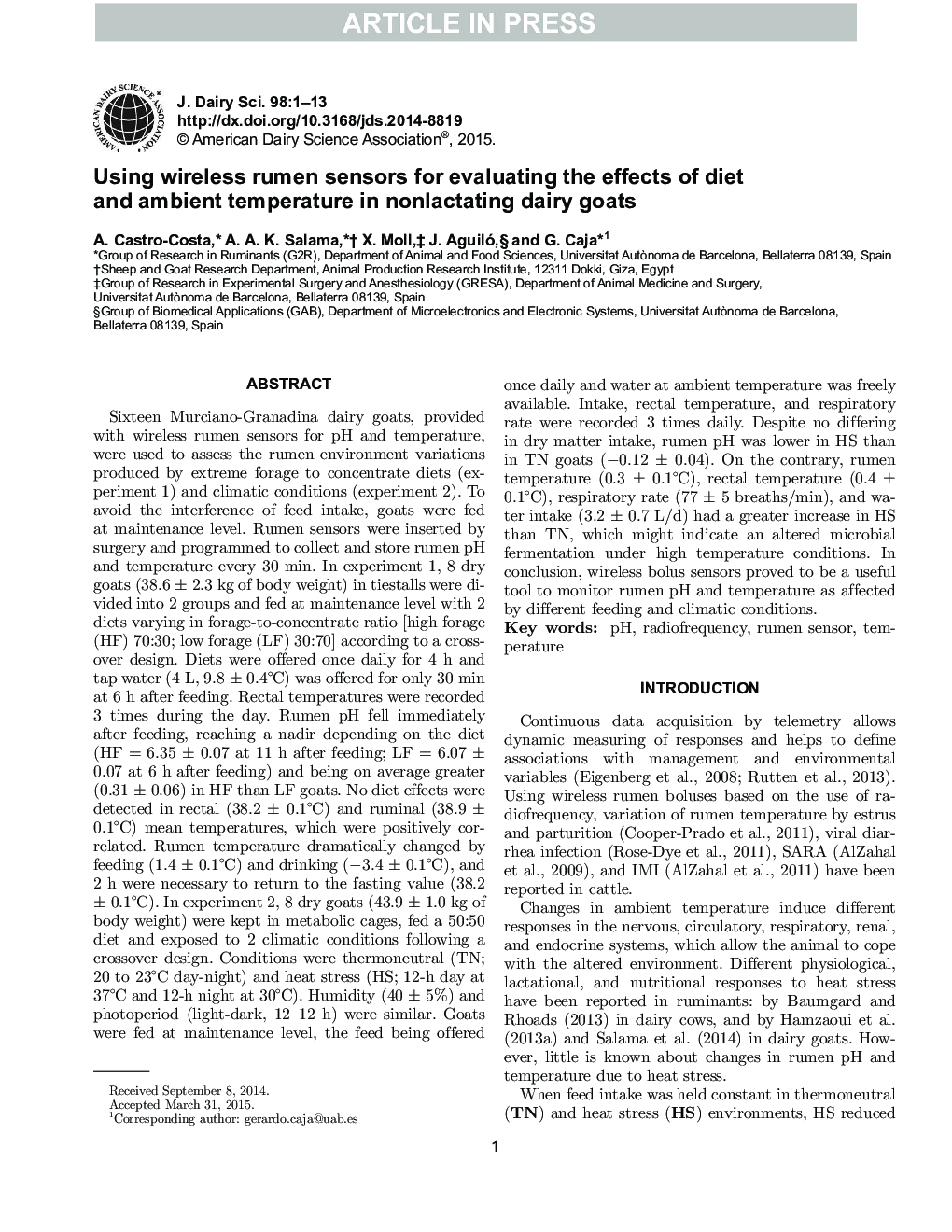| کد مقاله | کد نشریه | سال انتشار | مقاله انگلیسی | نسخه تمام متن |
|---|---|---|---|---|
| 10975289 | 1108032 | 2015 | 13 صفحه PDF | دانلود رایگان |
عنوان انگلیسی مقاله ISI
Using wireless rumen sensors for evaluating the effects of diet and ambient temperature in nonlactating dairy goats
ترجمه فارسی عنوان
استفاده از حسگرهای بی حس کننده بیسکویت برای ارزیابی اثرات رژیم غذایی و دمای محیط در بز های شیری غیر لخته
دانلود مقاله + سفارش ترجمه
دانلود مقاله ISI انگلیسی
رایگان برای ایرانیان
کلمات کلیدی
موضوعات مرتبط
علوم زیستی و بیوفناوری
علوم کشاورزی و بیولوژیک
علوم دامی و جانورشناسی
چکیده انگلیسی
Sixteen Murciano-Granadina dairy goats, provided with wireless rumen sensors for pH and temperature, were used to assess the rumen environment variations produced by extreme forage to concentrate diets (experiment 1) and climatic conditions (experiment 2). To avoid the interference of feed intake, goats were fed at maintenance level. Rumen sensors were inserted by surgery and programmed to collect and store rumen pH and temperature every 30 min. In experiment 1, 8 dry goats (38.6 ± 2.3 kg of body weight) in tiestalls were divided into 2 groups and fed at maintenance level with 2 diets varying in forage-to-concentrate ratio [high forage (HF) 70:30; low forage (LF) 30:70] according to a crossover design. Diets were offered once daily for 4 h and tap water (4 L, 9.8 ± 0.4°C) was offered for only 30 min at 6 h after feeding. Rectal temperatures were recorded 3 times during the day. Rumen pH fell immediately after feeding, reaching a nadir depending on the diet (HF = 6.35 ± 0.07 at 11 h after feeding; LF = 6.07 ± 0.07 at 6 h after feeding) and being on average greater (0.31 ± 0.06) in HF than LF goats. No diet effects were detected in rectal (38.2 ± 0.1°C) and ruminal (38.9 ± 0.1°C) mean temperatures, which were positively correlated. Rumen temperature dramatically changed by feeding (1.4 ± 0.1°C) and drinking (â3.4 ± 0.1°C), and 2 h were necessary to return to the fasting value (38.2 ± 0.1°C). In experiment 2, 8 dry goats (43.9 ± 1.0 kg of body weight) were kept in metabolic cages, fed a 50:50 diet and exposed to 2 climatic conditions following a crossover design. Conditions were thermoneutral (TN; 20 to 23°C day-night) and heat stress (HS; 12-h day at 37°C and 12-h night at 30°C). Humidity (40 ± 5%) and photoperiod (light-dark, 12-12 h) were similar. Goats were fed at maintenance level, the feed being offered once daily and water at ambient temperature was freely available. Intake, rectal temperature, and respiratory rate were recorded 3 times daily. Despite no differing in dry matter intake, rumen pH was lower in HS than in TN goats (â0.12 ± 0.04). On the contrary, rumen temperature (0.3 ± 0.1°C), rectal temperature (0.4 ± 0.1°C), respiratory rate (77 ± 5 breaths/min), and water intake (3.2 ± 0.7 L/d) had a greater increase in HS than TN, which might indicate an altered microbial fermentation under high temperature conditions. In conclusion, wireless bolus sensors proved to be a useful tool to monitor rumen pH and temperature as affected by different feeding and climatic conditions.
ناشر
Database: Elsevier - ScienceDirect (ساینس دایرکت)
Journal: Journal of Dairy Science - Volume 98, Issue 7, July 2015, Pages 4646-4658
Journal: Journal of Dairy Science - Volume 98, Issue 7, July 2015, Pages 4646-4658
نویسندگان
A. Castro-Costa, A.A.K. Salama, X. Moll, J. Aguiló, G. Caja,
